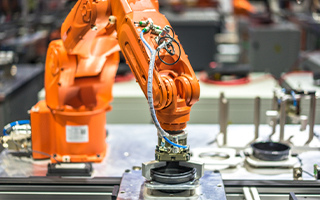Manufacturing IT: Why Your Factory Floor Demands a Different Playbook

The alarm goes off at 3 AM. Your automobile assembly line's part scanner is down—workers can't scan critical components, and cars aren't rolling off the line. Every minute costs you 4 vehicles in lost production, each worth $30,000. This isn't a typical IT outage—this is the reality of manufacturing IT.
After three decades of managing IT operations across automotive plants, steel mills, Pharma companies, chemical plants and garment factories, Microland had learned one fundamental truth: Manufacturing IT isn't just different—it's mission-critical in ways that corporate IT never imagines.
The Manufacturing IT Reality Check
While corporate CIO’s worry about email downtime, a manufacturing CIO is dealing with assembly lines that can't stop, legacy systems running Windows XP that control million-dollar machinery, and field engineers who need to climb 40-foot towers to access network access points while wearing full protective gear. The stakes? Production halts that cost millions per hour.
The math is brutal: A single day of downtime at a major automotive plant can cost $50-100 million. A cyber-attack on manufacturing systems doesn't just steal data—it can literally shut down production for weeks.
Digital Workplace & End User Computing: Beyond the Desk
The Challenge
Manufacturing "end users" aren't sitting at desks with dual monitors. They're operating $2 million CNC machines, managing robotic assembly lines, or troubleshooting equipment in hazardous environments where a tablet might be their only interface to critical systems.
Manufacturing-Specific Approach
- Rugged computing solutions that survive factory floors—dust, vibration, temperature extremes
- Role-based device strategies: Touch-screen terminals for operators, ruggedized tablets for maintenance crews, specialized HMI interfaces for control room staff
- Zero-downtime refresh cycles: You can't take production systems offline for routine updates
- Simplified interfaces for non-technical users who need to focus on production, not technology
Best Practice: Implement "Golden Hour" support protocols—field engineers positioned strategically across large facilities with pre-staged equipment and rapid response capabilities. A desktop issue in the stamping plant can't wait for help desk tickets.
Network: The Production Lifeline
The Challenge
Unlike corporate networks optimized for email and web browsing, manufacturing networks carry real-time control data, safety systems, and production telemetry that can't tolerate even milliseconds of latency.
Critical Requirements
- Segmented OT/IT networks with secure bridges
- Redundant fiber backbones across sprawling facilities
- Industrial grade switching and routing equipment
- Wireless networks designed for interference-heavy environments with metal machinery
- Deterministic networking for time-sensitive automation protocols
The Expansion Factor
When the company announces a new production line or facility expansion, you need network infrastructure that scales horizontally across acres of industrial space, not just vertically in office buildings. Plan for modular network architectures that can rapidly extend to new production areas.
Cloud: Manufacturing’s Complex Dance
The Challenge
It is difficult for manufacturing to go "cloud-first." Your blast furnace controls, robotic welding systems, and safety interlocks must remain on-premises for latency and reliability reasons. But analytics, planning systems, and supply chain management benefit enormously from cloud scalability.
Manufacturing Cloud Strategy
- Edge computing for real-time processing at the factory floor
- Hybrid architectures that keep control systems local while leveraging cloud analytics
- Industrial IoT platforms that can handle millions of sensor data points
- Disaster recovery that accounts for both IT systems and manufacturing execution systems
Expansion Readiness: Design cloud architectures that can rapidly onboard new facilities. When you're building a new plant or expanding operations in a country, your cloud infrastructure should enable rapid deployment of standardized manufacturing IT stacks.
Security: The New Battleground
The Challenge
Cybercriminals know that shutting down a production line creates immediate pressure for ransom payments. Manufacturing companies often pay because the cost of downtime exceeds the ransom demand.
Manufacturing Security Imperatives
- Air-gapped critical systems where possible
- Zero-trust architectures for OT networks
- Vulnerability management for legacy systems that can't be patched
- Incident response plans that prioritize production continuity
- Physical security integration with cybersecurity protocols
The Legacy Challenge
That Windows XP machine controlling your $10 million injection molding line? It can't be upgraded because the vendor doesn't support newer OS versions, but it can't be left unprotected.
Solution: Microsegmentation and behavioural monitoring to detect anomalies without disrupting operations.
Monitoring: Beyond Uptime
Manufacturing Monitoring Complexity
You're not just monitoring servers and applications—you're monitoring vibration sensors on bearings, temperature probes in furnaces, and pressure gauges in chemical processes. Your monitoring needs to correlate IT health with production metrics.
Integrated Approach
- Unified dashboards showing both IT infrastructure and production KPIs
- Predictive analytics that correlate IT issues with production impact
- Alert prioritization based on production criticality
- Cross-functional war rooms that include both IT and production teams
The Expansion Imperative: Building for Growth
Manufacturing CIOs must architect for expansion from day one. Whether it's a new production line, facility acquisition, or greenfield site, your IT infrastructure needs "expansion-ready" design principles:
- Standardized technology stacks that can be rapidly deployed
- Centralized management platforms that scale across global operations
- Pre-negotiated vendor agreements for rapid equipment procurement
- Modular data center designs that can be replicated
The Million-Dollar Mistake: Treating Manufacturing IT Like Corporate IT
The companies that fail are those that apply corporate IT practices to manufacturing environments. They focus on cost optimization over reliability, treat network outages as minor inconveniences rather than production disasters, and underestimate the complexity of operational technology integration.
The result? Production halts that cascade through supply chains, safety incidents from poorly maintained systems, and vulnerability to cyber attacks that can shut down operations for weeks.
The bottom line: Manufacturing IT isn't just about keeping systems running—it's about keeping production flowing, workers safe, and your company competitive in a global marketplace where downtime isn't just expensive—it's potentially fatal to your business.
The next time someone suggests treating your manufacturing IT like any other enterprise environment, remind them that when their email goes down, people are inconvenienced. When your manufacturing systems go down, people lose jobs. We at Microland understand this. Reach out to us.

















